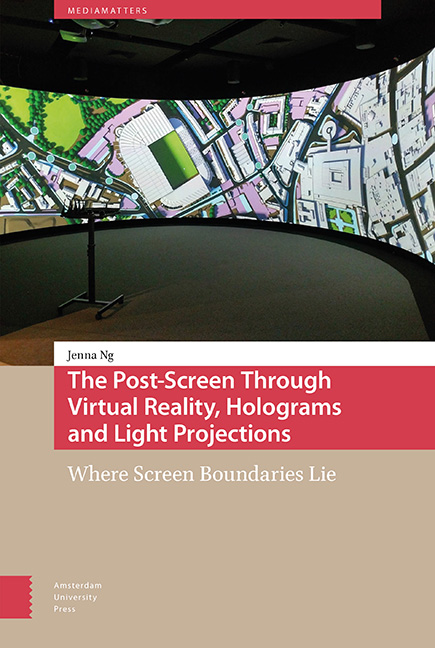 The Post-Screen through Virtual Reality, Holograms and Light Projections
The Post-Screen through Virtual Reality, Holograms and Light Projections Book contents
- Frontmatter
- Dedication
- Table of Contents
- Acknowledgements
- Introduction
- 1 Screen Boundaries as Movement
- 2 Leaking at the Edges
- 3 Virtual Reality: Confinement and Engulfment; Replacement and Re-placement
- 4 Holograms/Holographic Projections : Ghosts Amongst the Living; Ghosts of the Living
- 4A (Remix) True Holograms: A Different Kind of Screen; A Different Kind of Ghost
- 5 Light Projections: On the Matter of Light and the Lightness of Matter
- Conclusion/Coda
- Index
4A - (Remix) True Holograms: A Different Kind of Screen; A Different Kind of Ghost
Published online by Cambridge University Press: 16 December 2021
- Frontmatter
- Dedication
- Table of Contents
- Acknowledgements
- Introduction
- 1 Screen Boundaries as Movement
- 2 Leaking at the Edges
- 3 Virtual Reality: Confinement and Engulfment; Replacement and Re-placement
- 4 Holograms/Holographic Projections : Ghosts Amongst the Living; Ghosts of the Living
- 4A (Remix) True Holograms: A Different Kind of Screen; A Different Kind of Ghost
- 5 Light Projections: On the Matter of Light and the Lightness of Matter
- Conclusion/Coda
- Index
Summary
Abstract
This chapter discusses true holograms as a “remix” discussion from Chapter 4 of ghosts out of the post-screen. Commonly confused with holographic projections, true holograms are two-dimensional images naturally viewed (i.e. without optical aids) as 3-dimensional objects. Leveraging theoretical sources such as Deleuze's notion of “the brain is the screen” and Vilém Flusser's ideas of point culture and linearity, the chapter argues for the post-screen through the true hologram whose ghosts are not of the spectral return of the dead, but digital apparitions via which the human mind ideates and projects realities. These digital ghosts thus return with a necromancy of their own on the terms of zerodimensionality and post-rationality, confronting us with new problems of reality and questions about ourselves.
Keywords: hologram; screen; brain; screen; ghost; Flusser; crisis of linearity
Screens and Ghosts, or, the Window and the Guy in the Basement
In Parasite, the widely acclaimed and first ever non-English language film to win the Academy Award for best picture, there are two houses. In one lives a poor family; in the other, a rich family.
The house with the poor family is semi-basement, with one window which opens onto the outside world at street level. The architectural window becomes a screen through which the family, enclosed in the darkness of their largely subterrestrial home, sees sights of the outside street. But, as with the post-screen, the window's boundaries are open, porous and permeable, so the window also lets in fumigation fumes and, at the film's climax, rain floods which pollute and destroy their home. We can say that this is a different kind of screen.
The house with the rich family has a hidden basement with a guy in it. He had once emerged from the basement to steal food from the kitchen and frightened the rich family's little son, who refers to the episode as having “seen a ghost.” This guy turns out to be the original housekeeper's husband who had been secretly living in the basement bunker for over four years hiding from loan sharks – indeed, a man with a ghosted identity.
- Type
- Chapter
- Information
- The Post-Screen through Virtual Reality, Holograms and Light ProjectionsWhere Screen Boundaries Lie, pp. 189 - 206Publisher: Amsterdam University PressPrint publication year: 2021
